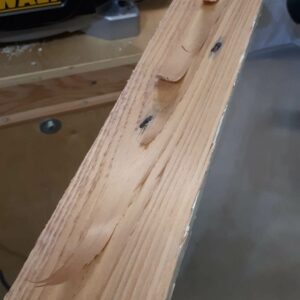I’m planing some 20 year old, well dried 1 x 4 rough cedar boards that had solid stain on them. Maybe not the kindest thing to do to my planer knives, but up here in Yukon it’ll be cheaper to replace the knives than buy planed cedar. I’m using a DeWalt DW735 and making 1/32″ passes on the finishing speed. Most of the boards are turning out fine, but a few end up with long thin curly bits standing up (see photo).
Is it something I’m doing or is it the nature of the wood? I’m feeding the board in the direction it’s pointing in the photo, so I can’t see that being the issue. Feeding it the other way would surely tear those pieces out.
















Replies
It’s in the wood, nothing you can do, the layers between growth rings separated during drying.
I agree wit Gulfstar. Cedar can be an odd duck to work with. It looks like its just the nature of the wood. Your best bet may be to cut those boards narrower or shorter
Here in Tennessee we have a similar problem with cypress; it often comes apart along the growth rings. Use solid parts of the board, or use other boards that stay solid. The official name for this problem is "wind shakes" as it can often be traced to stresses that the tree has been thru. I have some quarter sawn red oak from a 46" tree. Turns out it survived a tornado that felled its twin next to it back in the 1930s. It is "shakey" where the tornado disrupted the growth. Made the lumber difficult to work with, as the wind shakes are not always visible on the outside of the boards, but can become so when you plane it.
That makes sense. Thanks for the detailed explanation.
It's nothing you did. Wood's gonna do what wood's gonna do.
Thank you all for taking the time to reply.
I once was given an air-dried cedar board but could not get usable lumber out of it. Brittle and prone to split.
This forum post is now archived. Commenting has been disabled